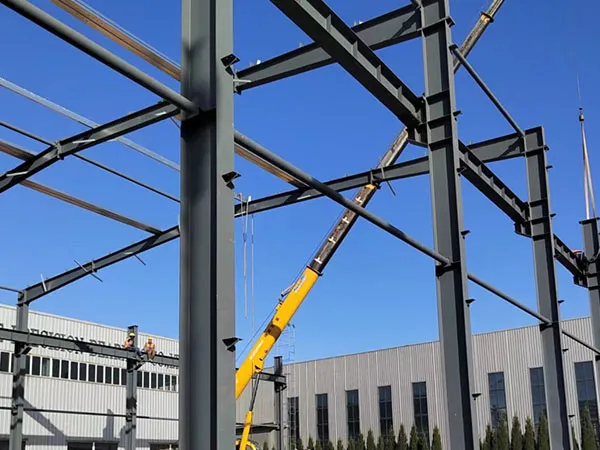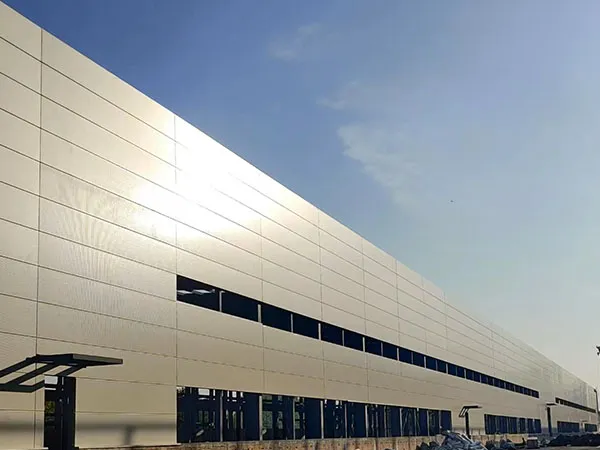Time:2025-04-28 02:41:32 Source:Sanjian Meichen Steel Structure
To prevent corrosion in steel structures, a multi-faceted approach is essential, addressing design, material selection, surface preparation, and protective coatings.

Minimize Moisture Traps: Design details should prevent water accumulation and allow for drainage. Inclined surfaces, drainage holes, and avoiding sharp edges can help.
Ensure Adequate Ventilation: Promote air circulation around the steel structure to reduce humidity and the time of wetness. Seal box sections unless they are to be galvanized, in which case provide vent and drain holes.
Avoid Contact with Dissimilar Materials: Prevent or insulate contact between different metals (bimetallic connections) to avoid galvanic corrosion. Similarly, separate steel from timber using coatings or plastic sheets. Ensure proper concrete cover and quality to protect embedded steel.
Facilitate Coating Application and Maintenance: Design for easy access for applying and inspecting protective coatings.
Choose Appropriate Steel Grades: Consider using weathering steel (which forms a protective rust layer), stainless steel (for high corrosion resistance), or pre-coated steels like galvanized steel, galvalume steel, or pre-painted steel, depending on the environment.
Consider the Environment: Select materials and protection systems based on the corrosivity of the environment (e.g., coastal, industrial, or interior).
Thorough Cleaning: Before applying any protective coating, the steel surface must be clean and free of rust, mill scale, oil, grease, and other contaminants.
Methods include abrasive blast cleaning, power tool cleaning, and chemical cleaning (acid pickling). The chosen method depends on the initial condition of the steel and the requirements of the coating system.
Create a Suitable Surface Profile: Some coatings require a specific surface roughness (anchor profile) to ensure proper adhesion. Blast cleaning with angular abrasives creates this profile.

Paint Systems: Applying multi-layer paint systems is a common method. These typically include a primer (often zinc-rich for cathodic protection or epoxy-based for adhesion and corrosion inhibition), an intermediate coat (to build thickness), and a topcoat (for weather resistance and aesthetics).
Metallic Coatings:
Hot-Dip Galvanizing: Immersing steel in molten zinc creates a robust, corrosion-resistant alloy layer bonded to the steel.
Thermal Spraying (Metallizing): Spraying molten metal (like zinc or aluminum) onto the steel surface.
Electroplating: Applying a thin layer of metal (like zinc or nickel) using an electrolytic process.
Sherardizing: Heating steel components with zinc dust to create a zinc-iron alloy coating.
Other Coatings: Consider specialized coatings like epoxy coatings, polyurethane coatings, fluoropolymer coatings, and cementitious coatings, depending on the specific application and environmental conditions.
Duplex Systems: Combining galvanizing with a paint system can provide enhanced and long-lasting corrosion protection. The paint acts as a barrier, and the zinc provides cathodic protection if the paint is damaged.

Corrosion Inhibitors: Chemicals can be added to the environment or incorporated into coatings to slow down corrosion.
Cathodic Protection: This technique makes the steel structure the cathode in an electrochemical cell, preventing corrosion by using a sacrificial anode (a more reactive metal that corrodes instead of the steel) or an impressed current.
Regular Inspection and Maintenance: Periodic inspections can identify early signs of corrosion, allowing for timely repairs and reapplication of protective coatings, extending the structure's lifespan.
By implementing these strategies, you can significantly reduce the risk of corrosion and ensure the long-term integrity and safety of steel structures. The specific methods chosen will depend on factors such as the environment, the type of steel, the intended lifespan of the structure, and economic considerations.